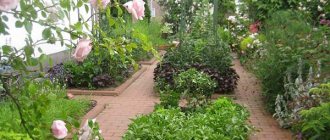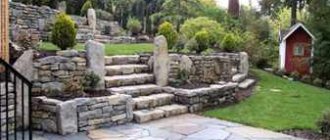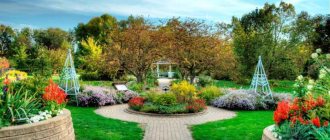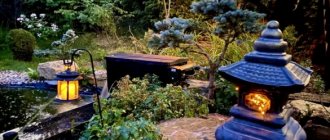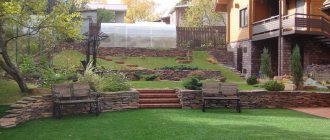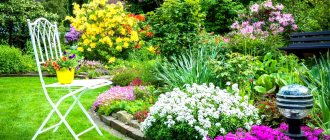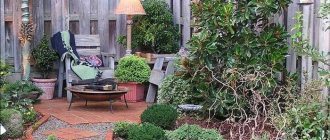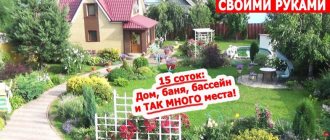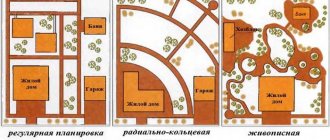Indoor geranium is familiar to most people since childhood. The second name of the flower is pelargonium; its use in garden landscaping has recently become widespread. This is due to the attractive appearance of the plant, diversity of species and high medicinal properties. A more thorough acquaintance with an old acquaintance will reveal many interesting facts and, perhaps, in the near future your dacha will be decorated with aesthetic geraniums.
Characteristics of the plant
Pelargonium comes from South Africa, its ability to bloom throughout the summer has ensured its widespread use not only as a houseplant, but also as a decoration for a balcony or cottage.
Landscape design specialists prefer geraniums when arranging the territory for several reasons:
- easy care;
- the variety of species allows you to elegantly complement any composition;
- Possibility of planting in containers.
Various types of geranium can be presented as herbaceous plants or subshrubs and are perennial crops. In addition to a wide color palette, pelargonium inflorescences have a variety of shapes: they can be shields, umbrellas or large terry “caps”. Geranium stems are straight, creeping or branched, while the leaves have a decorative appearance.
Top dressing
Organic fertilizers should never be used to feed geraniums. It is best to saturate the soil with mixtures of potassium, phosphorus and nitrogen in equal proportions.
By feeding geranium with potassium, you will definitely wait for it to bloom. But be sure to control the amount of it in the fertilizers used - it should not be too large.
Proper care of pelargonium involves saturating the soil:
- calcium;
- zinc;
- manganese;
- copper;
- iron;
- magnesium;
- boron
To do this, it is best to use ready-made fertilizers for indoor plants. For example, an excellent option would be to use “Merry Flower Girl” or the “For Flowering Plants” mixture.
If it's hot outside, you shouldn't feed the geranium - it will be stressful for it. First, move the plant to the shade, and only then add fertilizer to the soil. At the same time, do not forget to water the flower in advance.
It is advisable to feed pelargonium twice a month.
Nutrition is especially important for her in spring and summer.
Choosing a favorable place
To get geraniums that bloom for a long time in the landscape design of your dacha, you need to create favorable conditions for it. At the initial stage, you should select a place that meets the requirements for the quality development of the plant. Preference is given to open, sunny areas of the dacha; semi-shaded areas are also acceptable.
Pelargonium loves moist air and fertile soil with good drainage properties.
Advice! When choosing a place in landscape design for classic types of geranium, the location of the groundwater level is taken into account; the plant does not like moisture being too close to the root system.
Rules for planting in open ground
Although pelargonium is a perennial flower, the climate of the middle zone in winter is excessively harsh for it. Therefore, when growing in open ground, there are some features of landscape design with geraniums:
- The optimal soil for a flower is neutral or slightly acidic.
- The soil structure is light, the presence of river sand or peat is welcome.
- When digging in autumn, it is recommended to add mineral fertilizers and humus.
- Watering should be moderate, preventing the soil from drying out. Geranium will withstand short-term drought.
- For the growth and development of pelargonium, the optimal air temperature is +15°C. Therefore, light shade in hot climates is welcome.
The diversity of species suggests distinctive characteristics of plants, but in most cases the conditions for planting and care are the same. To root green cuttings at the dacha, they are planted in a mixed composition of river sand and peat; at home, perlite will come to the rescue.
Varieties of garden perennial geranium: descriptions with photos
Geraniums cultivated in Russia comprise several groups of herbaceous winter-hardy shrubs. Geraniums are valued for their large seasonal growth, branching, variety of shapes and colors of leaves and buds. The height of the bush, depending on the variety, varies from 15 cm to 1.5 m. The shoots are dense, strong, and the spreading spherical bush is beautiful at any time of the year, not only during the flowering period. In the middle zone, popular varieties are mainly grown.
Pelargonium can be a herbaceous or subshrub plant
Pelargonium zonale
Combines subshrubs with woody shoots.
Characteristic features of the group:
- a dark brown, dark green or yellowish spot in the center of the leaf blade, the contrast depends on the light, the chemical composition of the soil;
- specific tart aroma of leaves and flowers.
This type of pelargonium tolerates drought well and absolutely does not tolerate excess moisture.
There are varieties with semi-double and double flowers, collected in inflorescences, single-color and two-color petals. There is a great variety of zonal pelargonium; photos of flowers in a flowerbed surprise with their variegated colors.
Hybrids have been developed that have pleasant fruity and herbaceous aromas.
Pelargonium zonalis – Bravo Pastel variety with white and pink petals
Pelargonium peltatum
An ampelous subshrub that forms shoots up to 1 m long. The leaves are fleshy, pentagonal in shape. Due to the similarity of the leaf plates to the shield, the flower is often called thyroid pelargonium.
Pelargonium ivy - a favorite of gardeners for vertical or horizontal gardening
The flowers are simple, semi-double or double, formed on a long peduncle, forming umbellate inflorescences. Color ranges from white to burgundy with the exception of yellow and greenish shades. Flowers are simple, semi-double and double.
Georgian geranium (Geranium ibericum)
Drought-resistant, shade-loving, abundantly flowering varietal variety with small purple flowers up to 4.5 cm in diameter. The culture is resistant to fungal infections and pests.
The variety is characterized by a powerful and dense bush that blooms in early summer
The height of the bush is 60–80 cm, the foliage has rounded edges, there is pubescence. In autumn, the leaf blades turn red.
Swamp geranium (Geranium palustre)
Early flowering variety, blooms in June. It features medium-sized purple or pink flowers. The height of a dense bush is up to 20 cm, taking into account the length of peduncles - up to 70 cm.
Adult bushes of marsh geranium bloom for about a month
It grows in flooded areas with high groundwater levels, near artificial reservoirs. The variety does not require light and grows well in partial shade.
Meadow geranium (Geranium pratense)
A sun-loving plant species, not very demanding on the composition of the soil. In the group there are varieties that form a bush from 50 to 100 cm in height, including peduncles.
Meadow geranium is native to Europe, Western China and Central Asia.
The inflorescences are umbrella-shaped, the flowers are large with rounded petals. The color of the buds is lilac-blue, bright. Suitable for solitary planting on parterre lawns.
Magnificent geranium (Geranium × magnificum)
A medium-sized hybrid up to 50 cm high, obtained by crossing Georgian and flat-petalled geraniums. The leaves are pubescent, carved, five-parted, and acquire an orange-brown tint in autumn.
The hybrid blooms profusely in places well lit by the sun.
The variety has a long flowering period from early July to mid-September. Flowers do not produce seeds; the hybrid is propagated by cuttings or by dividing the bush.
Forest geranium (Geranium sylvaticum)
A wild-growing species, found in floodplains and along roadsides. The leaves are green, round in shape. The flowers are simple, 5-petalled, open, forming an umbrella. The color of the buds is blue-violet.
It is advisable to plant forest geraniums in damp places.
The plant blooms in June. Forest geranium in the garden photo design of the site, use for group planting.
Pelargonium care
Being in the garden at the dacha, geranium is able to bloom all summer. But every living organism needs rest, so about 2 months before the onset of winter cold, pelargonium goes into a state of rest. This is very simple to do; just stop watering the flowers and feeding them with mineral fertilizers. With the beginning of spring, geranium will awaken and illuminate the dacha with new blooms. It is better not to take risks with overwintering the plant in the open ground; it is much safer to transplant the pelargonium into a pot and transport it home.
In order for the landscape design of a dacha to be adorned with lush flowering geraniums for a long time, it requires complex fertilizing intended for flowering plants and regular loosening of the soil.
Pruning will help awaken the active growth of pelargonium in the spring; for this, the tops of the shoots are pinched. It is not necessary to throw them away; by rooting the waste in your dacha, you will receive additional geranium flowers in the landscape design of the site.
Watering pelargonium requires a dosed approach. This plant does not like overly moist soil. Geranium will tolerate a natural excess of moisture formed as a result of long rains, but artificial irrigation in quantities exceeding the need can lead to the death of the plant.
Advice! Wilted geranium leaves located in the lower part of the trunk are prone to rapid death. It is not recommended to leave them on pelargonium; regular pruning of drooping greenery will preserve the strength of the rest of the flower.
In the autumn, when the geranium begins to dry out and wither, the leaves and above-ground shoots are removed and taken outside the garden area.
Blooming indoor geranium as a garden decoration
Let's start with the selection of pelargoniums for borders and mixborders. I would prefer low-growing zonal pelargoniums, from which it is easier to create ribbon patterns and decorative stripes. I would take a closer look at small-leaved and variegated forms.
For edging flower beds I would choose plain, low bushes. They can not be planted in the ground, but grown in advance in small plastic or peat pots, which can be easily placed close to each other.
Pelargoniums are often planted in flowerpots made of plastic, concrete or ceramic. In one such container, bushy zonal pelargoniums in the central part and ampelous ivy-leaved pelargoniums along the edges look good together.
In rural areas you can often see flower beds in car tires. Sometimes the “wheels” are painted with bright colors and created from them into structures that even include old wheels. In these flower beds, indoor geraniums with flowers of different colors are planted. This variegation is suitable for a rustic style, but is not appropriate in most other styles.
Standard pelargoniums always attract attention. A tree from zonal pelargonium is obtained after repeated pruning or as a result of grafting (with a scion from ivy-leaved pelargonium)
These plants need to be selected in the most prominent places on the site or included “trees” in complex multi-level garden compositions.
Pelargoniums are often grown in balcony boxes. I plant the bushes in the soil that the box is filled with. Or I put separate pots in it. If the balcony box does not have a built-in tray, then I make sure that water does not stagnate there after rain or watering.
Pelargonium outside the window
When decorating open balconies, it is better to take ivy-leaved pelargoniums and low-growing zonal varieties. Tall bushes have a large windage and can shade other plants and block the view from the window.
Pelargonium decorated this old house
Pelargonium is an ideal plant for hanging baskets and planters. You can plant individual plants in them or create interesting garden compositions.
Plastic shelves and other vertical structures. Geraniums allow you to diversify flowering towers and columns with cascading flowers.
You can decorate the area with a flowering pyramid made by yourself. Its basis will be a frame of poles as a support. Pots or other containers with plants are placed inside a low pyramid or reinforced in tiers using various internal supports and wires in a tall structure. From time to time it is necessary to distribute and tie up long shoots of hanging varieties of pelargonium.
Breeding conditions
You can decorate the landscape design of your dacha with geraniums endlessly; the large number of species will not allow monotony. There are two main ways to propagate pelargonium - vegetatively (green cuttings) and by sowing seeds.
Which method is more convenient and effective, decide for yourself, having first read the conditions of each:
- Winter is the most suitable period for starting the propagation of geraniums, since by the beginning of spring, the landscape design of the dacha can already be complemented by new sprouts of the favorite flower. The vegetative method involves planting a pelargonium cutting in perlite or sand and then moistening it. The cuttings are cut from a geranium mother plant, transported from the dacha and stored at home at a temperature not exceeding +12°C. From January, in conditions of 16-degree heat, geranium cuttings begin to take root, after which the temperature can be increased by another 5 degrees. The root system of the pelargonium shoot is formed within 20 days; after the process is completed, the geranium can be transplanted into compact pots and placed in a greenhouse for the purpose of hardening. Further development before planting at the dacha can be continued on the window.
- The period for seed propagation of geranium is similar to the cutting method; the winter months are most optimal for starting the pelargonium breeding procedure. The seeds are placed in a prepared mixture consisting of peat and river sand. The absence of the latter is not a significant problem. After 20 days, the first shoots of the future beautiful geranium should appear. During this period, the soil is moistened and covered with film. After the formation of three full-fledged leaves on a young pelargonium, the seedlings are planted in separate containers. In order for geraniums in the country to have a bushy shape, after 6 leaves the plant is pinched.
Comment! Geranium is prone to rapid growth, so when planting pelargonium in the ground at the dacha, make sure there is enough free space.
Appreciate the beauty of the red pelargonium flower bed in the following photo:
We design flower beds
Flowerbeds can be of different shapes: oval, rectangular, triangular and curly.
By type they are:
- Monoflower, consisting of flowers of the same variety and color;
- Arabesque is a flowerbed with a complex shape;
- Vertical;
- Raised - the height of such flower beds can reach 1 meter;
- Regular - flowers are arranged in a geometric pattern.
Making a simple flowerbed with your own hands is not difficult. To do this, you need to first draw up a plan where the flowers will be planted.
You will also need the following tools to work:
- Shovel;
- Wheelbarrow;
- Master OK.
And materials:
- Bricks;
- Sand or gravel;
- Cement mortar;
- A piece of flexible plastic.
Sequencing:
- The selected area must be cleared of debris, weeds and roots removed. We limit and outline the boundaries of the future flower bed;
- We dig a hole (20 - 40 cm deep) and then thoroughly compact the soil inside. We fill in gravel. To create a rounded shape, we limit the boundaries of the future flower bed with flexible plastic and secure it. Then we lay bricks around the perimeter to create a kind of rim. We close all gaps with cement mortar;
- We wait until the solution dries. After this, we fill the soil so that a hill is formed in the central part of the flowerbed;
- Leave the soil like this for 14 days. During this time it will settle and settle. Afterwards we make holes and plant seedlings. For beginners, it will be more practical to make one large flower bed with a simple shape. If desired, it can be upgraded into more complex compositions.
To make the flower bed pleasing to the eye as long as possible, you need to plant plants with different flowering times. From May to June, daffodils, tulips, primroses, lilacs, crocuses, and saxifrage bloom. From June to July - peonies, bearded iris, carnations, cornflowers, delphiniums. From July to August - bluebells, calendula, daisies, phlox, pansies, petunias and roses. From August to September - chrysanthemum, gladioli, asters and dahlias.
Diseases and pests
Geraniums in the country are usually not prone to diseases, but landscape design experts warn about possible minor damage to the flower by powdery mildew or brown spot. Timely cutting of the plant at the dacha immediately after flowering will help prevent the spread of the disease. This helps to strengthen the geranium; healthy young shoots will withstand the autumn cold snap. This also applies to large pelargonium bushes damaged by disease in the country. At the end of the flowering period, they are completely mowed down. A new healthy plant will grow in their place.
If geranium is damaged by brown spot, the shoots are immediately pruned and destroyed by fire. Infection with a fungal infection occurs exclusively in rainy and cold summers; the geranium bush as a whole is not in serious danger.
Occasionally, damage to the root system of pelargonium by beetle larvae occurs. In this case, the geranium stops growing. Dried edges of leaves appear as a result of being eaten by an adult beetle. You can detect pests at night by digging up the plant and checking the root. If larvae are detected, they should be eliminated; the root and entire pelargonium flower are sprayed with a fungicide solution .
